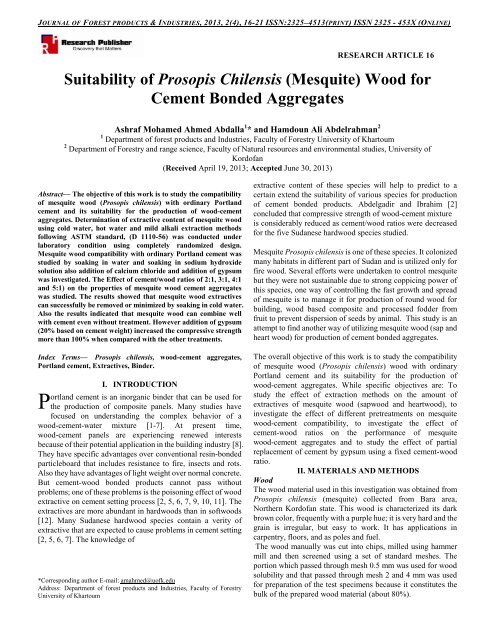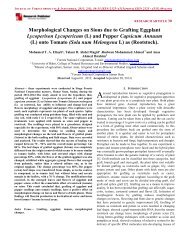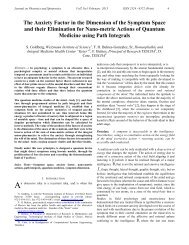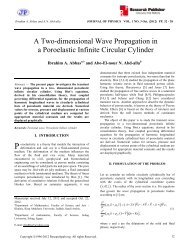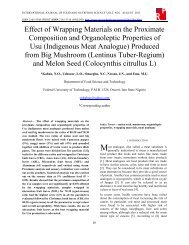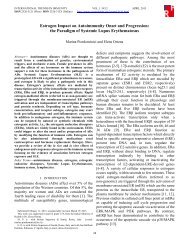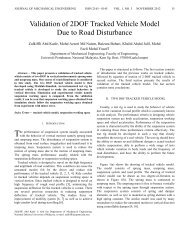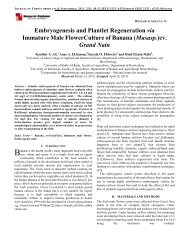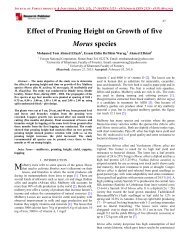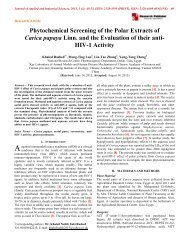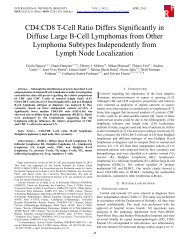(L) Seeds on Germination of Striga Hermonthica (Del.) Benth Seeds
(L) Seeds on Germination of Striga Hermonthica (Del.) Benth Seeds
(L) Seeds on Germination of Striga Hermonthica (Del.) Benth Seeds
Create successful ePaper yourself
Turn your PDF publications into a flip-book with our unique Google optimized e-Paper software.
JOURNAL OF FOREST PRODUCTS & INDUSTRIES, 2013, 2(4), 16-21 ISSN:2325–4513(PRINT) ISSN 2325 - 453X (ONLINE)RESEARCH ARTICLE 16Suitability <strong>of</strong> Prosopis Chilensis (Mesquite) Wood forCement B<strong>on</strong>ded AggregatesAshraf Mohamed Ahmed Abdalla 1 * and Hamdoun Ali Abdelrahman 21 Department <strong>of</strong> forest products and Industries, Faculty <strong>of</strong> Forestry University <strong>of</strong> Khartoum2 Department <strong>of</strong> Forestry and range science, Faculty <strong>of</strong> Natural resources and envir<strong>on</strong>mental studies, University <strong>of</strong>Kord<strong>of</strong>an(Received April 19, 2013; Accepted June 30, 2013)Abstract— The objective <strong>of</strong> this work is to study the compatibility<strong>of</strong> mesquite wood (Prosopis chilensis) with ordinary Portlandcement and its suitability for the producti<strong>on</strong> <strong>of</strong> wood-cementaggregates. Determinati<strong>on</strong> <strong>of</strong> extractive c<strong>on</strong>tent <strong>of</strong> mesquite woodusing cold water, hot water and mild alkali extracti<strong>on</strong> methodsfollowing ASTM standard, (D 1110-56) was c<strong>on</strong>ducted underlaboratory c<strong>on</strong>diti<strong>on</strong> using completely randomized design.Mesquite wood compatibility with ordinary Portland cement wasstudied by soaking in water and soaking in sodium hydroxidesoluti<strong>on</strong> also additi<strong>on</strong> <strong>of</strong> calcium chloride and additi<strong>on</strong> <strong>of</strong> gypsumwas investigated. The Effect <strong>of</strong> cement/wood ratios <strong>of</strong> 2:1, 3:1, 4:1and 5:1) <strong>on</strong> the properties <strong>of</strong> mesquite wood cement aggregateswas studied. The results showed that mesquite wood extractivescan successfully be removed or minimized by soaking in cold water.Also the results indicated that mesquite wood can combine wellwith cement even without treatment. However additi<strong>on</strong> <strong>of</strong> gypsum(20% based <strong>on</strong> cement weight) increased the compressive strengthmore than 100% when compared with the other treatments.Index Terms— Prosopis chilensis, wood-cement aggregates,Portland cement, Extractives, Binder.PI. INTRODUCTIONortland cement is an inorganic binder that can be used forthe producti<strong>on</strong> <strong>of</strong> composite panels. Many studies havefocused <strong>on</strong> understanding the complex behavior <strong>of</strong> awood-cement-water mixture [1-7]. At present time,wood-cement panels are experiencing renewed interestsbecause <strong>of</strong> their potential applicati<strong>on</strong> in the building industry [8].They have specific advantages over c<strong>on</strong>venti<strong>on</strong>al resin-b<strong>on</strong>dedparticleboard that includes resistance to fire, insects and rots.Also they have advantages <strong>of</strong> light weight over normal c<strong>on</strong>crete.But cement-wood b<strong>on</strong>ded products cannot pass withoutproblems; <strong>on</strong>e <strong>of</strong> these problems is the pois<strong>on</strong>ing effect <strong>of</strong> woodextractive <strong>on</strong> cement setting process [2, 5, 6, 7, 9, 10, 11]. Theextractives are more abundant in hardwoods than in s<strong>of</strong>twoods[12]. Many Sudanese hardwood species c<strong>on</strong>tain a verity <strong>of</strong>extractive that are expected to cause problems in cement setting[2, 5, 6, 7]. The knowledge <strong>of</strong>*Corresp<strong>on</strong>ding author E-mail: amahmed@u<strong>of</strong>k.eduAddress: Department <strong>of</strong> forest products and Industries, Faculty <strong>of</strong> ForestryUniversity <strong>of</strong> Khartoumextractive c<strong>on</strong>tent <strong>of</strong> these species will help to predict to acertain extend the suitability <strong>of</strong> various species for producti<strong>on</strong><strong>of</strong> cement b<strong>on</strong>ded products. Abdelgadir and Ibrahim [2]c<strong>on</strong>cluded that compressive strength <strong>of</strong> wood-cement mixtureis c<strong>on</strong>siderably reduced as cement/wood ratios were decreasedfor the five Sudanese hardwood species studied.Mesquite Prosopis chilensis is <strong>on</strong>e <strong>of</strong> these species. It col<strong>on</strong>izedmany habitats in different part <strong>of</strong> Sudan and is utilized <strong>on</strong>ly forfire wood. Several efforts were undertaken to c<strong>on</strong>trol mesquitebut they were not sustainable due to str<strong>on</strong>g coppicing power <strong>of</strong>this species, <strong>on</strong>e way <strong>of</strong> c<strong>on</strong>trolling the fast growth and spread<strong>of</strong> mesquite is to manage it for producti<strong>on</strong> <strong>of</strong> round wood forbuilding, wood based composite and processed fodder fromfruit to prevent dispersi<strong>on</strong> <strong>of</strong> seeds by animal. This study is anattempt to find another way <strong>of</strong> utilizing mesquite wood (sap andheart wood) for producti<strong>on</strong> <strong>of</strong> cement b<strong>on</strong>ded aggregates.The overall objective <strong>of</strong> this work is to study the compatibility<strong>of</strong> mesquite wood (Prosopis chilensis) wood with ordinaryPortland cement and its suitability for the producti<strong>on</strong> <strong>of</strong>wood-cement aggregates. While specific objectives are: Tostudy the effect <strong>of</strong> extracti<strong>on</strong> methods <strong>on</strong> the amount <strong>of</strong>extractives <strong>of</strong> mesquite wood (sapwood and heartwood), toinvestigate the effect <strong>of</strong> different pretreatments <strong>on</strong> mesquitewood-cement compatibility, to investigate the effect <strong>of</strong>cement-wood ratios <strong>on</strong> the performance <strong>of</strong> mesquitewood-cement aggregates and to study the effect <strong>of</strong> partialreplacement <strong>of</strong> cement by gypsum using a fixed cement-woodratio.II. MATERIALS AND METHODSWoodThe wood material used in this investigati<strong>on</strong> was obtained fromProsopis chilensis (mesquite) collected from Bara area,Northern Kord<strong>of</strong>an state. This wood is characterized its darkbrown color, frequently with a purple hue; it is very hard and thegrain is irregular, but easy to work. It has applicati<strong>on</strong>s incarpentry, floors, and as poles and fuel.The wood manually was cut into chips, milled using hammermill and then screened using a set <strong>of</strong> standard meshes. Theporti<strong>on</strong> which passed through mesh 0.5 mm was used for woodsolubility and that passed through mesh 2 and 4 mm was usedfor preparati<strong>on</strong> <strong>of</strong> the test specimens because it c<strong>on</strong>stitutes thebulk <strong>of</strong> the prepared wood material (about 80%).
JOURNAL OF FOREST PRODUCTS & INDUSTRIES, 2013, 2(4), 16-21 ISSN:2325–4513(PRINT) ISSN 2325 - 453X (ONLINE)17Cement and other materialsPortland cement produced by Atbra cement Corporati<strong>on</strong>, Sudanwas used as binding material for all experiments. Other materialused includes, calcium chloride CaCl 2 used as cement settingaccelerator. Sodium hydroxide NaOH used as pretreatmentsolvent and gypsum CaSO 4 .2H 2 O used as chemical additives.Methodsvsome <strong>of</strong> the promising results obtained in the first threeexperiments will be used in the latter <strong>on</strong>e. These experimentsare, determinati<strong>on</strong> <strong>of</strong> extractive c<strong>on</strong>tent <strong>of</strong> mesquite wood(extractives solubility) using cold water, hot water and mildalkali extracti<strong>on</strong> methods following ASTM standard, 1981 (D1110-56)[13], selecti<strong>on</strong> <strong>of</strong> the best pretreatment/s to be appliedto mesquite wood to improve its compatibility with ordinaryPortland cement (soaking in water, soaking in sodiumhydroxide soluti<strong>on</strong>, additi<strong>on</strong> <strong>of</strong> calcium chloride and additi<strong>on</strong> <strong>of</strong>gypsum); investigati<strong>on</strong> <strong>of</strong> the effect <strong>of</strong> cement/wood ratios (2:1,3:1, 4:1 and 5:1) <strong>on</strong> the properties <strong>of</strong> mesquite wood cementaggregates and studying the effect <strong>of</strong> cement partial replacementby gypsum when low cement wood ratio (3:1) was used.The effect <strong>of</strong> Extracti<strong>on</strong> methods <strong>on</strong> mesquite wood extractivec<strong>on</strong>tentCold water extracti<strong>on</strong>Two grams <strong>of</strong> milled oven dry wood were soaked into 300 ml <strong>of</strong>distilled water and left for 48 hours at room temperature, thesoluble porti<strong>on</strong> was filtered, and then the residues were washedwith distilled water and dried into an oven at 105ºC. Dryingprocess was c<strong>on</strong>tinued until c<strong>on</strong>stant weight was obtained, thenthe extractive c<strong>on</strong>tent was calculated based <strong>on</strong> the initial sampleweight.Hot water extracti<strong>on</strong>Two grams <strong>of</strong> (oven dry) milled sieved wood were soaked into100 ml <strong>of</strong> hot distilled water and maintained at 70ºC in waterbath for three hours, then the sample was treated as in cold waterextracti<strong>on</strong>.Mild alkali extracti<strong>on</strong>sTwo c<strong>on</strong>centrati<strong>on</strong>s <strong>of</strong> Sodium hydroxide soluti<strong>on</strong> wereprepared, (namely 0.5% and 1%) and used as extracti<strong>on</strong> agent.Two grams <strong>of</strong> milled sieved wood were soaked in 100 ml <strong>of</strong>0.5% sodium hydroxide soluti<strong>on</strong> and maintained in a water bathat 97-100ºC for <strong>on</strong>e hour, and then the sample was treated as incold water treatment.Effect <strong>of</strong> pretreatments applied to mesquite woodThe pretreatments used for mesquite wood to improve itscompatibility with Portland cement were, soaking in cold water,additi<strong>on</strong> <strong>of</strong> calcium chloride, soaking in 1% sodium hydroxideand additi<strong>on</strong> <strong>of</strong> gypsum.Soaking in cold waterFor cold water treatment wood particles were soaked in tapwater for two weeks. Every two days, water was replaced byclean water to remove water soluble extractive that dissolved,and then the wood particles were air dried for <strong>on</strong>e week. Using afixed cement wood ratio <strong>of</strong> 2:1 and the appropriate amount <strong>of</strong>water, a mixture <strong>of</strong> wood, cement and water was prepared fromwhich five experimental specimens were produced. Theappropriate amount <strong>of</strong> water was calculated according to thefollowing equati<strong>on</strong>:[6]W= 0.35C+ (0.3-MC) ×W oWhereW: water/LC: Cement weighs KgW o : Oven dry weigh <strong>of</strong> wood KgMC: Moisture c<strong>on</strong>tent <strong>of</strong> woodThe specimens were prepared using metallic mould <strong>of</strong> 7×7×7cm.Then the specimens were left for 24 hours for cement setting,and the metallic mould was removed from the specimens afterwhich the specimens were soaked in water for 28 days in orderto allow complete curing <strong>of</strong> cement.Soaking in sodium hydroxide soluti<strong>on</strong>The wood particles were soaked in 1% sodium hydroxidesoluti<strong>on</strong> for 24 hours, and then the particles were washed severaltimes with tap water to remove the sodium hydroxide andextractive. They were left to air dry after that five specimenswere prepared using the same method described in the previoussecti<strong>on</strong>.Additi<strong>on</strong> <strong>of</strong> Calcium chloride (CaCl 2 )Based <strong>on</strong> cement weight 3% <strong>of</strong> calcium chloride was added tothe wood, cement and water mixture. Five specimens wereprepared from this mixture in the same way as in the precedingsecti<strong>on</strong>s.Additi<strong>on</strong> <strong>of</strong> GypsumBased <strong>on</strong> cement weight 20% <strong>of</strong> commercial gypsum was addedto the mesquite wood cement mixture and then the experimentproceeded as in the cold water treatment to produce fiveexperimental units.C<strong>on</strong>trolUntreated wood from Prosopis chillensis (mesquite) was mixedwith cement using the same ratio as c<strong>on</strong>trol to compare theabove menti<strong>on</strong>ed pretreatments. Five specimens were producedusing the same method as that used for cold water treatment.The effect <strong>of</strong> cement/wood ratios <strong>on</strong> the properties <strong>of</strong>mesquite wood cement aggregatesUsing Completely Randomized Design (CRD) with fivereplicates. Four cement wood ratios namely 2:1, 3:1, 4:1 and 5:1were used. Wood particles were mixed with Portland cementwithout any treatment or additives, the required amount <strong>of</strong> waterwas added, then the mixture was molded into testing metallicmold <strong>of</strong> (7×7×7 cm) and left for 24 hours for setting. Then theresulting cubes were soaked in water for four weeks forcomplete cement curing.
JOURNAL OF FOREST PRODUCTS & INDUSTRIES, 2013, 2(4), 16-21 ISSN:2325–4513(PRINT) ISSN 2325 - 453X (ONLINE)18The effect <strong>of</strong> cement partial replacement by gypsum <strong>on</strong> theproperties <strong>of</strong> Mesquite wood cement aggregatesUnder completely randomized design with five replicates usinga fixed cement wood ratio <strong>of</strong> 3:1, four levels <strong>of</strong> cementreplacement by gypsum were d<strong>on</strong>e. The selected levels <strong>of</strong>replacement were 10, 20, 30 and 50% based <strong>on</strong> cement weight.Wood particles were mixed with Portland cement, and thegypsum according to each level <strong>of</strong> replacement, and thenproceeded as in the effect <strong>of</strong> cement wood ratio experiment.Another replicate was molded without any gypsum to serve asc<strong>on</strong>trol.Property measurementAll the specimens were tested for water absorpti<strong>on</strong> for 2 and 24hour, density and compressive strength according to ASTMStandard (D-1039).Statistical AnalysisThe data collected from the above menti<strong>on</strong>ed experiments wasanalyzed using (SAS) s<strong>of</strong>tware [14]. Analysis <strong>of</strong> variance andmean separati<strong>on</strong> test using Duncan’s multiple range tests.III. RESULTS AND DISCUSSIONSEffect <strong>of</strong> extracti<strong>on</strong> methodsTable 1 shows the result <strong>of</strong> the mean separati<strong>on</strong> test for theeffect <strong>of</strong> different extracti<strong>on</strong> methods used to determine theextractives c<strong>on</strong>tent <strong>of</strong> mesquite wood. One percent mild alkaliextracti<strong>on</strong> method gave the highest c<strong>on</strong>tent and wassignificantly different from cold and hot water extracti<strong>on</strong>methods, while no significant differences was observed between1 and 0.5% mild alkali extracti<strong>on</strong> method. Also no significantdifferences was found between 0.5% mild alkali extracti<strong>on</strong> andcold water method, which was not significantly different fromhot water extracti<strong>on</strong>. Generally as the severity <strong>of</strong> extracti<strong>on</strong>method increase the percentage <strong>of</strong> extractive c<strong>on</strong>tent increased.These c<strong>on</strong>clusi<strong>on</strong> not agreed with the findings <strong>of</strong> Mohammed[15] when he c<strong>on</strong>cluded that, the extractive c<strong>on</strong>tents <strong>of</strong> thestudied species (Acacia nilotica, Calotropis Procera,Cupressus lusitanica and Eucalyptus microtheca) variedbetween 5.9% and 11.2% when extracted with cold water,between 19.5% and 25.65 when extracted with hot water andbetween 23% and 39.6% when extracted with NaOH 1% andincreased by increasing the severity <strong>of</strong> extracti<strong>on</strong> method. Theseresults indicated that mesquite wood extractive can successfullybe removed or minimized by soaking in cold water.Table 1The effect <strong>of</strong> extracti<strong>on</strong> methods <strong>on</strong> mesquite wood extractivec<strong>on</strong>tentExtracti<strong>on</strong> methodExtractive c<strong>on</strong>tent (%)NaOH 1%NaOH 0.5%Cold waterHot water31.07a28.60ab20.19bc12.60cIn the same column, means with the same letter/s are notsignificantly different at P =0.05Effect <strong>of</strong> wood pretreatment <strong>on</strong> some properties <strong>of</strong> mesquitewood cement b<strong>on</strong>ded aggregatesThe results <strong>of</strong> the mean separati<strong>on</strong> test for the effect <strong>of</strong> woodpretreatment <strong>on</strong> the air dry density, compressive strength andwater absorpti<strong>on</strong> percentage (2 and 24 hours) <strong>of</strong> the mesquitewood cement b<strong>on</strong>ded aggregate is presented in Table 2.Regarding air dry density significant difference was foundbetween additi<strong>on</strong> <strong>of</strong> gypsum and other pretreatments, theadditi<strong>on</strong> <strong>of</strong> gypsum rank first, while no differences wereobserved between additi<strong>on</strong> <strong>of</strong> calcium chloride and untreatedwood (c<strong>on</strong>trol) which were significantly different from eithersoaking in cold water or 1% sodium hydroxide soluti<strong>on</strong>. Asexpected, additi<strong>on</strong> <strong>of</strong> gypsum increases the air dry density andthis obviously due to high density <strong>of</strong> gypsum itself. Also thisfinding was not in line with the finding <strong>of</strong> Ahn and Moslemi [16]who observed that CaCl 2 tends to improve the b<strong>on</strong>d betweenwood and cement and rank first, while in this study additi<strong>on</strong> <strong>of</strong>calcium chloride ranks sec<strong>on</strong>d and share the same ranks withuntreated wood. From the above discussed results it can bec<strong>on</strong>cluded that mesquite wood can combine well with cementeven without treatment.Table 2Effect <strong>of</strong> wood pretreatments <strong>on</strong> mesquite wood cementb<strong>on</strong>ded aggregate some propertiesTreatment Density Compressive Water absorpti<strong>on</strong> (%)(g/cm 3 )strength(kgf/cm 2 )2 hours 24 hoursGypsum 1.126 a 51.318 a 45.423 a 50.286 aCalcium1.009 b 24.799 b 32.491 b 37.582 bchlorideC<strong>on</strong>trol 0.9972 b 24.675 b 24.688 c 28.126 cCold water 0.9176 c 23.223 b 22.708 c 26.489 cdNaOH 1% 0.8338 d 09.123 c 18.796 c 22.736 dIn the same columns, means with the same letter/s were notsignificantly different at 0.05
JOURNAL OF FOREST PRODUCTS & INDUSTRIES, 2013, 2(4), 16-21 ISSN:2325–4513(PRINT) ISSN 2325 - 453X (ONLINE)19The results <strong>of</strong> the mean separati<strong>on</strong> test for the effect <strong>of</strong> differentwood pretreatments <strong>on</strong> compressive strength (Kg/cm 2 ) showedthat additi<strong>on</strong> <strong>of</strong> gypsum gave the highest value and wassignificantly different from all other treatments followed byc<strong>on</strong>trol, additi<strong>on</strong> <strong>of</strong> calcium chloride and soaking in cold water,between which no differences were found. Extracti<strong>on</strong> by NaOH1% was ranked last, and this may be attributed to the adverseeffect <strong>of</strong> the sodium in lowering the air dry density, in this studyincreasing density associated with better properties and this isgoes in total agreement with the finding <strong>of</strong> abdalgadir andIbrahim [2] who stated that the compressive strength is highlycorrelated with the density <strong>of</strong> wood cement mixture. Previousworks <strong>of</strong> Hassan [17] and Ibrahim [18] c<strong>on</strong>cluded that, additi<strong>on</strong><strong>of</strong> calcium Chloride help in improving the compressive strengthand ranked first, while in this study additi<strong>on</strong> <strong>of</strong> calcium chlorideranked sec<strong>on</strong>dly. Additi<strong>on</strong> <strong>of</strong> gypsum (20% -based <strong>on</strong> cementweight) increased the compressive strength more than 100%compared with the others treatments and displaced calciumchloride from the top rank. This may possibly be due toincreased air dry density. An exciting result was that soakingmesquite wood in cold water as well as c<strong>on</strong>trol shared the samerank with additi<strong>on</strong> <strong>of</strong> calcium chloride, which indicated thatmesquite wood can safely be used to produce cement b<strong>on</strong>dedproducts without any sort <strong>of</strong> treatment. This may be attributed tothe fact that the extractives present in mesquite wood did nothave an inhibitory effect <strong>on</strong> cement setting.As shown in Table 2 the results <strong>of</strong> the mean separati<strong>on</strong> test forthe effect <strong>of</strong> wood pretreatment <strong>on</strong> the water absorpti<strong>on</strong>percentage <strong>of</strong> mesquite wood – cement b<strong>on</strong>ded aggregates.,additi<strong>on</strong> <strong>of</strong> gypsum, additi<strong>on</strong> <strong>of</strong> calcium chloride and c<strong>on</strong>trolsgave the best result when soaked for two hours and were notsignificantly different from each other, but were significantlydifferent from soaking in cold water and soaking in 1% sodiumhydroxide soluti<strong>on</strong> (Table 2). But when soaking was extendedto 24 hours, additi<strong>on</strong> <strong>of</strong> gypsum and additi<strong>on</strong> <strong>of</strong> calciumchloride significantly improved water absorpti<strong>on</strong>, while c<strong>on</strong>trolranked third, but not significantly different from additi<strong>on</strong> <strong>of</strong>calcium chloride. Soaking in 1% sodium hydroxide soluti<strong>on</strong>opposite was true. The results <strong>of</strong> mean separati<strong>on</strong> test for theeffect <strong>of</strong> cement/ wood ratio <strong>on</strong> water absorpti<strong>on</strong> are shown in 7revealed that, significant differences between the ratios wereobserved when the specimens were soaked for 2 hours, with thetrend that as cement wood ratio increased water absorpti<strong>on</strong>decreased. This result goes in total agreement with the finding<strong>of</strong> Elten [21] who found that the water absorpti<strong>on</strong> tended todecrease as the amount <strong>of</strong> cement was increased from 50:50 to30:70. Obviously, a higher wood c<strong>on</strong>tent (lower cement: wood:ratio), would result in greater water absorpti<strong>on</strong> due the nature <strong>of</strong>wood which will be less surrounded by cement, but increasingthe cement ratio results in better coating <strong>of</strong> wood particles. Thisprevents them from absorbing water. There were alsosignificant differences between ratios when specimens weresoaked for 24 hours, which indicate that the aggregatesshowed the highest percentage <strong>of</strong> water absorpti<strong>on</strong>. Generallypretreating any hardwood improves water absorpti<strong>on</strong>percentage due to improvement <strong>of</strong> cement setting c<strong>on</strong>diti<strong>on</strong>s.Previous work by Hassan [17] and Ashraf and abdalazim [5]c<strong>on</strong>cluded that the additi<strong>on</strong> <strong>of</strong> calcium chloride significantlyimproved water absorpti<strong>on</strong> percentage. However additi<strong>on</strong> <strong>of</strong>gypsum in this study showed better aggregate performance thanadditi<strong>on</strong> <strong>of</strong> calcium chloride.Effect <strong>of</strong> cement/wood ratios <strong>on</strong> the density <strong>of</strong> mesquitewood/cement b<strong>on</strong>ded aggregatesMean separati<strong>on</strong> test results for the effect <strong>of</strong> cement wood ratio<strong>on</strong> mesquite wood-cement b<strong>on</strong>ded aggregates air dry density,compressive strength and water absorpti<strong>on</strong> percentage (2 and 24hours) were presented in Table 3. Regarding air dry density, nosignificant differences were observed between ratios 4:1 and5:1which gave the highest value. But there were significantdifferences between the other ratios. As expected increasingcement/wood ratio results in increased aggregate air dry densitysince additi<strong>on</strong> <strong>of</strong> more cement means increasing the specimenweight. The same c<strong>on</strong>clusi<strong>on</strong> was found by Zhou and Kamdem[19] who stated that, cement-b<strong>on</strong>ded particleboard that utilizelarge amounts <strong>of</strong> cement in comparis<strong>on</strong> to wood (cement: woodratio higher than 3:1), result in final product with high density(>1300 kg/m 3 ), because cement is denser than wood. AlsoOyagade et al., [20] reported that veneer laminatedcement-b<strong>on</strong>ded particleboard were str<strong>on</strong>ger and stiffer withincreased cement/wood ratio due to increased density.As shown in Table 3 significant differences were foundbetween the four studied ratios regarding compressive strength.As observed from the Table 3 increasing cement: wood ratioresulted in increasing compressive strength. This can beattributed to the increased air dry density. This goes in totalagreement with the finding <strong>of</strong> Abdelgadir and Ibrahim [2] whoc<strong>on</strong>cluded that compressive strength <strong>of</strong> cement- wood mixturefor five Sudanese hardwood species is c<strong>on</strong>siderably reduced ascement/wood ratios were decreased and theabsorbed huge amount <strong>of</strong> water during the first hours <strong>of</strong> soaking,while increasing the soaking time result in <strong>on</strong>ly a fewpercentages <strong>of</strong> increase (3-6%). which agreed well with thec<strong>on</strong>clusi<strong>on</strong> <strong>of</strong> Hassan [17] who c<strong>on</strong>cluded that soaking in waterfor 24 hours increased the amount <strong>of</strong> water absorpti<strong>on</strong> by anaverage <strong>of</strong> 6% compared to soaking for 2 hours. From all abovementi<strong>on</strong>ed results, it may be c<strong>on</strong>cluded that aggregates with lowcement wood ratio absorb more water and possesses lowercompressive strength. However, aggregates with highercement/wood ratio (4:1 and 5:1) absorb small amount <strong>of</strong> water,possesses higher compressive strength and heavy weight (highdensity). The aggregate produced with cement wood ratio <strong>of</strong> 3:1had reas<strong>on</strong>able weight, good strength and reliable density. Theoverall c<strong>on</strong>clusi<strong>on</strong> is that 3:1 cement wood ratio is the suitableand recommended ratio to be used for untreated mesquite wood.
JOURNAL OF FOREST PRODUCTS & INDUSTRIES, 2013, 2(4), 16-21 ISSN:2325–4513(PRINT) ISSN 2325 - 453X (ONLINE)20Table 3Effect <strong>of</strong> cement/wood ratios <strong>on</strong> some properties <strong>of</strong> mesquite wood/cement b<strong>on</strong>ded aggregatesCement/wood ratio Density Compressive strength Water absorpti<strong>on</strong> (%)(g/cm 3 )(kgf/cm 2 )2 hours 24 hours5:1 1.475 a 110.72 a 19.38 d 25.9 c4:1 1.394 a 90.90 b 23.64 c 27.9 c3:1 1.148 b 37.94 c 31.55 b 34.9 b2:1 0.822 c 16.59 d 44.66 a 50.8 aIn the same columns, means with the same letter/s were not significantly different at P= 0.05Table 4Effect <strong>of</strong> cement partial substitute by gypsum <strong>on</strong> some properties <strong>of</strong> mesquite wood/cement b<strong>on</strong>ded aggregatesGypsum replacement Density Compressive strength Water absorpti<strong>on</strong> (%)percentage (%) (g/cm 3 )(kgf/cm 2 )2 hours 24 hoursC<strong>on</strong>trol (0) 1.148 a 37.94 b 31.55 a 34.90 a10 1.097 b 56.89 a 26.45 b 29.85 b20 1.057 b 39.37 b 30.85 ab 33.84 ab30 1.034 b 25.74 c 33.90 a 37.76 a50 1.014 b 24.88 c 34.06 a 36.94 aIn the same columns, means with the same letter/s were not significantly different at P= 0.05Effect <strong>of</strong> cement partial substitute by gypsum <strong>on</strong> the density <strong>of</strong>mesquite wood/cement b<strong>on</strong>ded aggregatesThe results <strong>of</strong> the mean separati<strong>on</strong> test for the effect <strong>of</strong> cementpartial replacement by gypsum <strong>on</strong> mesquite wood-cementb<strong>on</strong>ded aggregates air dry density, compressive strength andwater absorpti<strong>on</strong> percentage (2 and 24 hours) were presented inTable 4. The mean separati<strong>on</strong> test for air dry density shows that,no significant differences were found between the differentpercentages <strong>of</strong> the substitute (10, 20, 30 and 50%, based <strong>on</strong>cement weight). But there is a trend <strong>of</strong> reducing density byincreasing the gypsum replacement percentage and statisticallyappear to be significant. In general the pure cement density isapproximately twice the density <strong>of</strong> the gypsum. This fact mayexplain the reducti<strong>on</strong> caused in specimens air dry density asgypsum replacement percentage increase.For the compressive strength the mean separati<strong>on</strong> test showedsignificant differences between all levels <strong>of</strong> replacement (10, 20,30 and 50%). The highest compressive strength was associatedwith 10% substitute which was significant differences from allother substitute levels. This was followed by 20%. However nosignificant differences were observed between 30 and 50%substitute. When comparing this result with c<strong>on</strong>trol, the c<strong>on</strong>trolcompressive strength showed no significant difference from that<strong>of</strong> 20% replacement, while 10% replacement improved thecompressive strength significantly over that <strong>of</strong> the c<strong>on</strong>trol. Thegypsum partial replacement <strong>of</strong> 10% increased the compressivestrength more than 100 percent when compared with thepercentage 30 and 50. This indicated that the partialreplacement <strong>of</strong> cement by gypsum in fewer amount is sufficientto improve the aggregates compressive strength. Whileincreasing the percentage more than 20% causes reducti<strong>on</strong> <strong>on</strong>compressive strength <strong>of</strong> the aggregate. This may be attributed tothe fact that increasing the amount <strong>of</strong> gypsum affected thesetting and curing process <strong>of</strong> cement through absorbing morewater, rendering insufficient amount <strong>of</strong> water for cement setting.Also a possible explanati<strong>on</strong> may be due to the decrease whichoccurred in the aggregate density. According to SudaneseStandard, the minimum requirement <strong>of</strong> compressive strength forburnt clay bricks should not be less than 20 Kg/cm 2 . Referringto the result <strong>of</strong> this experiment, the worst mesquite wood cementaggregates showed compressive strength <strong>of</strong> 24.8 Kg/cm 2 whichexceeds the required compressive strength by the standard.Lower percentages <strong>of</strong> substitute significantly improve waterabsorpti<strong>on</strong> <strong>of</strong> the aggregate when soaked for both 2 and 24hours as shown in Table 4. Increasing replacement percentagesignificantly increases water absorpti<strong>on</strong> for both periods <strong>of</strong>soaking. A possible explanati<strong>on</strong> may be that increasing gypsumpercentage takes more water during the molding, so negatively
JOURNAL OF FOREST PRODUCTS & INDUSTRIES, 2013, 2(4), 16-21 ISSN:2325–4513(PRINT) ISSN 2325 - 453X (ONLINE)21affect the process <strong>of</strong> cement setting. Which result in poorcoating <strong>of</strong> wood particles with cement, so when subjected tomoisture, they absorbed large quantity <strong>of</strong> water.IV. CONCLUSIONSBased <strong>on</strong> the findings and results <strong>of</strong> this study, the followingc<strong>on</strong>clusi<strong>on</strong>s can be drawn:-- Mesquite (Prosopis chilensis) wood extractives cansuccessfully be removed or minimized by soaking incold water.- Mesquite wood can combine well with cement evenwithout treatment.- Additi<strong>on</strong> <strong>of</strong> gypsum (10% based <strong>on</strong> cement weight)increased the compressive strength more than 100%when compared with the other treatments.- The additi<strong>on</strong> <strong>of</strong> gypsum resulted in better performancethan the additi<strong>on</strong> <strong>of</strong> Calcium chloride.- Increasing cement porti<strong>on</strong> resulted in increasedaggregates density, increased compressive strengthand lower percentage <strong>of</strong> water absorpti<strong>on</strong>.- The gypsum partial substitute <strong>of</strong> 10% increased thecompressive strength more than hundred percent whencompared with the percentage 30 and 50, thisexpressed that the partial substitute <strong>of</strong> cement bygypsum in fewer amount is sufficient to improve theaggregates compressive strength.REFERNCES[1] Sandermann, H.J. Preusser, and W. Shweers. 1960. The effect <strong>of</strong> woodextractives <strong>on</strong> the setting <strong>of</strong> cement-b<strong>on</strong>ded wood materials.Holzforschung 14(3):70-77.[2] Simatupang, M.H. 1979. The water requirement <strong>of</strong> manufacturedcement-b<strong>on</strong>ded particleboard. Holz Roh-Werkst 37:379-382.[3] Miller, D. P. 1987: Wood-cement composite: interacti<strong>on</strong>s <strong>of</strong> woodcomp<strong>on</strong>ents with Portland cement Ph.D. Dissertati<strong>on</strong>, University <strong>of</strong> Idaho,and Moscow, Idaho, USA.[4] Abdelgadir, A.Y. and M.F.S. Ibrahim 2003. Effect <strong>of</strong> pretreatments andcement/wood ratio <strong>on</strong> compatibility <strong>of</strong> wood with Portland cement. SudanSilva 9(2): 77-85.[5] Ashraf M.A. Abdalla and A.Y. Abdelgadir. 2006. Effect <strong>of</strong> particle size andcement/wood ratio <strong>on</strong> some properties <strong>of</strong> Acacia nilotica wood-cementaggregates. Sudan Silva 12(1): 41-52[6] Bashir, Amel, A; Abdelazim Y. A. and Osman T. Elzaki 2007. Effect <strong>of</strong>Cement/Wood Ratio, Calcium Chloride C<strong>on</strong>tent and Pressure <strong>on</strong>compressive Strength <strong>of</strong> Acacia seyal Wood-Cement Aggregates. SudanSilva 13 (1): 25-35.[7] Ashraf Mohamed Ahmed Abdalla; Tarig Tag Elsir Hassan; Abdelazim YassinAbdelgadir and Abdael Lateif El Tayeb Mahoumd. 2010. Effect <strong>of</strong> coldwater durati<strong>on</strong> extracti<strong>on</strong> and calcium chloride treatment <strong>on</strong> physicalproperties <strong>of</strong> Acacia nilotica wood-cement aggregates. Sudan Silva 14(1):1-9[8] Dinwoodie, J. M.; Pax<strong>on</strong>, B. M. 1983: wood cement particleboard- Atechnical assessment. Building Research Establishment informati<strong>on</strong>paper. IP 4/83:1-4.[9] Paramenwaran, V. N.; Broker, F. W.and Simatupang, M. H. 1977: Micromorphological studies <strong>on</strong> mineral-b<strong>on</strong>ded wood composite. Interacti<strong>on</strong>between binders and wood. Holzforschung 31: 173-178.[10] Parameswaran, V. N.; Broker, F. W. 1979; Micro morphologicalinvestigati<strong>on</strong> <strong>on</strong> wood- cement composite after l<strong>on</strong>g –term use.Holzforchung 33:97-102.[11] Abdelazim Yassin Abdelgadir and Ashraf M. Ahmed Abdalla. 2005.Effect <strong>of</strong> wood pretreatments <strong>on</strong> the modulus <strong>of</strong> rupture <strong>of</strong> Acacia niloticawood-cement aggregate. Sudan Silva 11(1): 79-84[12] Gnannaharan, R, and T. K. Dhamodaran, 1985. Suitability <strong>of</strong> sometropical hard wood for cement-b<strong>on</strong>ded wood-wool board manufacturesHolzforschung 39(6):337-340.[13] American Society <strong>of</strong> Testing and Materials 1956 (ASTM). Annual Book<strong>of</strong> ASTM Standards, Vol. 04-02. C39-83b.[14] SAS Institute Inc. 1990. SAS/STAT Guide for Pers<strong>on</strong>al computers. Versi<strong>on</strong>6 Ed. SAS Institute Inc., Carry, NC.[15] Mohammed, A.A 1999.The effect <strong>of</strong> wood extractives <strong>of</strong> someSudanese tree species <strong>on</strong> Portland cement setting M.Scthesis submitted tothe University Khartoum.[16] Ahn, W. Y.; Moslemi,A.A. 1980. SEM examinati<strong>on</strong> <strong>of</strong> Portland cementb<strong>on</strong>ds. Wood Sciences and Technology. 13: 17-82.[17] Hassan, T.T.E. 1999. Effect <strong>of</strong> Some Physical and Chemical additives <strong>on</strong>the mechanical and physical properties <strong>of</strong> Acacia nilotica wood cementmixture. M.Sc. Thesis submitted to the University <strong>of</strong> Khartoum.[18] Ibrahim. M. F. 1995. Effect <strong>of</strong> Species Treatment and Cement woodRatios <strong>on</strong> the Compressive Strength <strong>of</strong> Wood-Cement Mixture. M.Sc.Thesis, Faculty <strong>of</strong> Forestry, University <strong>of</strong> Khartoum-Sudan.[19] Zhou, Y.; Kamdem, D.P. 2002. Effect <strong>of</strong> cement/wood ratio <strong>on</strong> theproperties <strong>of</strong> cement-b<strong>on</strong>ded particleboard using CCA-treated woodremoved from service. Forest Products Journal 52 (2): 73-81.[20] Oyagade, A.O.; S.O.O. Badejo, and O. A. Omole 1995. A preliminaryevaluati<strong>on</strong> <strong>of</strong> flexural properties <strong>of</strong> wood-veneer laminatedcement-b<strong>on</strong>ded particleboard from tropical hardwood species. Journal <strong>of</strong>tropical forestry and wood technology <strong>of</strong> the timber Developmentassociati<strong>on</strong> <strong>of</strong> India 41 (3): 25-29.[21] Elten, G.V. 2000. Producti<strong>on</strong>, Properties and applicati<strong>on</strong> <strong>of</strong> various woodscement products. Especially wood Journal. September/October2000:18-24.


